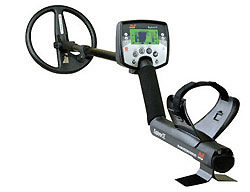Minelab Explorer XS, II and SE Pro - Metal Detectors I Used for Nine Years
My Short Reviews and Practical Tips
by Sergei UpstateNY, proficiency level: Beginner, last time modified:
During my seventh metal detecting season, I bought a Minelab Explorer XS and, five years later, acquired a Minelab Explorer II which I used for four years.

I used the Minelab Explorers for nine years in total, and these machines were my primary detectors for Coin Shooting, Cache Hunting and Relic Hunting because of their two innovative features: a 2-Dimentional Discrimination scale called 'Smartfind', and a FBS (Full Band Spectrum) system with 28 simultaneously operating frequencies (from Super Deep 1.5kHz to Ultra Sensitive 100kHz). My girlfriend at a time, Shelly, and I recovered many "goodies" including nice relics even at the "hammered out" sites. With the Minelab Explorers, I also managed to find a few large coin caches in the fields. Images of various keepers (not all of course) I found with the Explorers are shown in most of my stories listed in the following sections: Metal Detecting Stories and Metal Detecting Finds
Both the 'Smartfind' and FBS features seemed to be revolutionary for their time as they enabled the Minelab machines to outperform most advanced detectors of that period at the most problematic (highly mineralized and/or trashed) hunt sites. The Minelab Explorer XS was my first true 'Switch-On-and-Go' machine as it did not require complicated programming or frequent Ground Balance readjustments for stable and productive performance. From the start, instead of using the factory pre-set programs (I never use them anyway), I employed an Advanced Mode which allowed me to adjust the Explorer to most metal detecting conditions.
The 2-Dimensional Discrimination scale was incredibly helpful at the trashy sites because it allowed me to reject certain junk targets by their ferrous content ('FE' values) and not necessarily by their conductivity content ('CO' values) which many times would be the same as the 'CO' values of some desirable targets. Finding and recovering gold rings while rejecting and, therefore, not digging up many pull-tabs of the same conductivity on a beach could be one of many good examples.
I used the Minelab Explorer SE for a short while and did not like its performance comparing it to the Explorer II's performance. Something was not quite right with SE's electronics or its search coil, no matter what settings I used, even though the detector was just out of box. I heard similar complains from other users of Minelab Explorer SE, which made me think that whatever electronic modifications were incorporated into the SE's circuit, the detector's performance was not improved. On the contrary, it was the opposite.
Out of all Minelab Explorers I used, the Explorer II was definitely the best performer. I only wish it did not have the same poor body design as the physical body design of its ancestor - the Explorer XS. Due to weak materials initially used for the XS' shaft assembly, the Explorer XS' body would start falling apart after two months of being continuously used. Though, the Explorer II's shaft assembly was made from the long-lasting plastics, I reinforced it anyway just to be on a safe side, and modified an identical shaft assembly of the E-Trac - the Explorer's successor, the same way as explained in my article - How To Reinforce the Minelab Explorer's Body
The Minelab Explorer II also differed from the Explorer XS by a larger 1/4" headphone jack and a Dual Coordinate (Fe-Co) digital display. The clearly displayed 'Fe-Co' read-out (two numbers) allowed a metaldetectorist to see the target's Conductivity (CO) and Ferrous (FE) content simultaneously.
Unfortunately all my 'cosmetic' modifications of the Explorer II's body design did not make the detector somewhat ergonomic, i.e. it was still unbalanced, heavy-weight and hard to maneuver. Many Minelab users including myself hoped that the Minelab would drop this ridiculous concept of the Explorer's body design in favor of at least a classic S-shaped tube assembly in the upcoming models. But unfortunately the concept remained unchanged (until a new FBS detector - CTX 3030, was introduced to public in 2013). The Minelab Explorer's poor balance, cumbersome construction and heavy weight overshadowed all pro's including the innovative 'Smartfind' and FBS features. And the heavy weight still remains the biggest drawback of the CTX 3030 which weighs 5.20 lbs (2.36 kgs).
Introduced with the Minelab Explorer XS in 2000, the FBS technology was later inherited by the E-Trac and a few years later, in a form of an upgraded FBS 2, was incorporated into the Minelab CTX 3030. The XS' 2-Dimensional scale - 'Smartfind', was also incorporated into all subsequent Explorer models and then into both the E-Trac and its subsequent version CTX 3030 (in a form of a modified 'Smartfind2'). Unfortunately, both technologies already began falling behind a new, breaking through technology introduced by the XP Metal Detectors in their XP Deus machine back in 2009. The Minelab technologies that had ruled the market for almost a decade could no longer meet the requirements of the metal detecting reality that had dramatically changed by 2009.
If you would like to see the Search Program settings for Minelab Explorer XS, II, SE and SE Pro, please check My Search Program for Minelab Explorer
If you would like to see the Minelab Explorer II Pro's Features and Specifications and read other users' reviews, please visit the Minelab Explorer II Pro Reviews page
